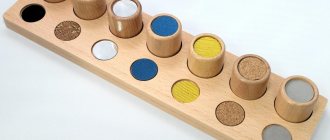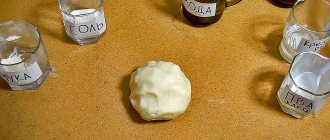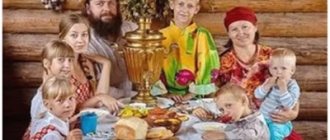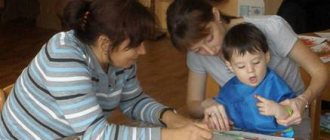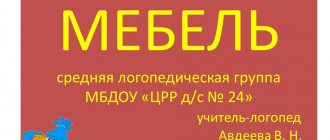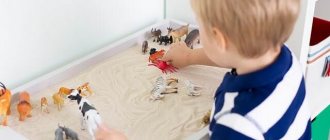Play activities with children 2 years old
Antonina Lomakina
Play activities with children 2 years old
The age of a child up to 3 years is the most favorable time for him to begin developing any abilities. Therefore, it is important not to miss the moment and start working with your child on time. Play is the first thing any child should be taught.
It is at the age of 3 that a child begins to attend kindergarten. The first days of kindergarten are one of the most exciting moments in the life of every family. What kind of teacher will the child get, will he like it in kindergarten, how quickly will he get used to the new environment, will he find friends, will he not be offended…. These and many more questions concern every parent.
A small child cannot yet occupy himself, he does not know what to do with this or that toy, and does not know how to communicate with peers and unfamiliar adults. Therefore, the main task of the teacher at this stage is to help the child adapt to an unusual environment as quickly as possible.
Adaptation to kindergarten is a complex and sometimes lengthy process, lasting from 1 to 3 weeks, but sometimes it drags on for six months or even a year!
The child’s entry into the team should be gradual. Now there are many short-stay groups. The task of such mini-groups is not only to raise a full-fledged and versatile personality, but also to help the child painlessly survive entering kindergarten.
In classes , children are introduced to the following types of games:
— mobile ( “Hide and Seek”
,
“Catch the Dog”
,
“Little-Big”
,
“Rain and Sunshine”
,
“Through the Stream”
,
“Sparrows and the Car”
)
- sports (crawling, climbing, walking, playing with balls, jumping, running)
- musical (playing musical instruments, guessing what sounds, listening to musical works)
— physical education
,
“Teddy bear”
; finger games:
“This finger is mother”
,
“White-sided magpie”
;
round dances “Like on our name day”
,
“Blow up, bubble”
- exercises for speech development (reading nursery rhymes, poems, fairy tales; games for understanding words “What is this?”
,
"What is he doing?"
,
“What is he like?”
— dramatization games (dramatization of fairy tales and nursery rhymes: “The Ryaba Hen”
,
"Turnip"
,
"Teremok"
etc. etc.)
- to develop fine motor skills of the hands (Move the peas, mosaic, remove clothespins, attach magnets, laces)
- articulation gymnastics (breathing exercise “Blowing on dandelions, cotton wool, water”
,
"Bubble"
)
- role-playing games with dolls and soft toys (feed, dress , comb hair, put to bed)
:
“Shop”
,
“Doctor”
,
“Washing the dishes”
- educational for the development of attention, memory, thinking “Match the doors to the houses”
,
“Who played what?”
,
“Find identical objects”
,
“Remove the extra object”
,
“What is the difference between objects”
- designing the construction of turrets, trains, houses from wooden parts
- drawing with colored pencils, gouache paints: with fingers, palms
- modeling from plasticine and clay
-applique, gluing parts pre-cut from colored paper
To make classes more effective , you need to pay attention to the following points:
- before the start of classes, read the game tasks , think over the lesson , prepare the necessary material;
— don’t forget about safety precautions! You must be sure that the child will not swallow or stick a small object into his nose or ear or fall;
— organize your work space, remove distracting objects;
— at the beginning of the lesson , it is necessary to arouse in children a desire for joint creativity;
- your speech should be clear;
- it is important that an adult takes direct part in all children’s games;
- if some people refuse to study, do not force games on them. Start an activity and very soon these children will want to join you;
- be kind and respectful to children;
— praise is an excellent incentive for the further development of a child. Don't forget about it!
What children from 2 to 3 years old should be able to do.
In order to assess how correctly a child is developing, you need to know what he should be able to do at the age of 2-3 years:
• Fulfill complex requests that consist of 2-3 actions. For example: go to the closet, open the door, take a jacket and close the door.
• Be able to speak simple phrases and understand parents.
• It is advisable to be able to undress and dress yourself. This is easy to teach by showing it a few times.
• Use the potty independently and wash your hands.
• Cut paper with scissors. This is not dangerous.
• Build simple buildings from cubes or construction sets; • Assemble a pyramid from 8 parts;
• Assemble a logic cube by matching the parts correctly to the holes. The main thing is not to rush the child. If he doesn't understand what you want from him, come up with an easier task. And then add one more point. Don't forget that many things are new to the child. Help your child in everything, and be sure to show patience, because he may not always succeed in everything the first time.
Features of organizing and conducting educational activities with young children
Vereshchagina Lyubov
Features of organizing and conducting educational activities with young children
Features of organizing and conducting direct educational activities with young children .
Early age is a special , extremely important and responsible period in a person’s life. In terms of the intensity of mastery of skills and abilities, in terms of the pace of development, early age has no parallel in subsequent periods. All the child’s activities are subordinated to one leading need - knowledge of the world around him and himself in it.
In the first three years of life, the most important and fundamental abilities : cognitive activity, curiosity, self-confidence, focus and perseverance, imagination and many others. Moreover, all these abilities do not arise on their own, as a consequence of the child’s young age , and their development requires the mandatory participation of the teacher.
For the full mental development of a child, special forms of teaching young children and certain pedagogical influences are necessary. However, these influences have serious specifics and differ in many respects from those that are usually used for preschool children .
The leading type of activity and the basis for the formation of the personality of a young is object-based play activity. Therefore, with children of this age we conduct games-activities in which the assimilation of any material occurs unnoticed by the children, in play activities.
Complex classes are an interesting and, most importantly, effective form of development. The peculiarity of these classes is that they combine several areas: speech development, familiarization with the outside world, sensory development, visual activity, design. Activities include nursery rhymes, poems, short stories, didactic and finger games, actions with objects, games with water and sand, experiments ( “drowning - not drowning”
,
“cold, warm, hot”,
etc., theatrical activities and much more.
classes in the form of a game , since game techniques ensure dynamic learning and maximally satisfy the child’s needs for speech or behavioral independence (movements, actions, etc.)
.
Classes with young children differ from classes with preschoolers not only in the volume and content of the material, but also in specific teaching . We conduct them individually or with a small subgroup of children. The teacher sits at the same table with the children to be able to help each child.
In order to structure the work in the best possible way, the teacher must also have a good understanding of the psychological characteristics of the development of young children : features of the development of perception , attention and memory, speech and thinking, etc.
So, when working with young children, we take into account the following principles;
1. The child learns about the world with the help of the teacher through imitation.
Kids explore with interest the sensory properties of surrounding objects, open and close, throw, touch, smell, taste. But only with the help of a teacher does the child learn their functional purpose: they eat soup with a spoon, dig sand with a shovel, read a book, draw with a pencil.
The teacher introduces the child to new games when he teaches how to lull a doll, build with blocks, or roll a car by a string. By observing the teacher and repeating his movements, actions, words, the child learns new skills, learns to speak, serve himself, and becomes more independent.
Thus, we build lessons with children on imitation of the teacher, his movements, actions and words, and not on explanation, conversation, or suggestion.
2. In the joint activities of the child and the teacher, we combine elements of play and learning.
Young children , mobile and inquisitive. Childhood spontaneity underlies knowledge of the world around us and communication with people. Children have not yet formed the concept of what is good and what is bad, how they can behave and how they cannot. Teaching children is possible only when the child’s positive emotions are affected. Such an emotional uplift can only be achieved in a game. A conscious attitude towards learning will appear later - in older preschool age . Until then. If the baby is not interested, he will simply turn away or leave.
Thus, we introduce learning elements into specially organized games .
3. For a new skill to stick, repetition is necessary.
Kids love to repeat the same action, movement, word over and over again. This is a learning mechanism: for a skill to become established, a large number of repetitions are needed, and the more complex the skill, the more time and number of repetitions it will take.
The assumption that it is necessary to constantly add variety to the child's games and activities is correct for older children . And kids feel more comfortable in a familiar situation and act more confidently during familiar, favorite games.
Thus, in order for new knowledge, skills and abilities to be consolidated, we repeat the material many times.
4. The content of the material must correspond to children's experience.
materials for games and activities with young children in such a way that its content corresponds to children's experience. We use situations familiar to the baby. For example, we organize a game with a car after the children saw cars on the street; game "Kitty, kitty - scat!"
- after the children saw and stroked the cat.
If we offer new material, then we first give the child new ideas. For example, the game “Hen and Chicks”
.
Small city children often have no real idea about poultry, so we show the child toys - a hen and chicks - or pictures, talk a little about these poultry, and then start playing. We consolidate, clarify, and expand the same plots in different classes. Reusing familiar stories when working with young children is completely justified and useful.
Thus, we select material for classes with children seriously and thoughtfully.
5. Control of the level of complexity of the proposed material.
The level of difficulty of the material for classes with children is age appropriate . If a child is faced with a task beyond his strength, he obviously finds himself in a situation of failure. The kid tries to complete the task, but he fails, and he quickly loses interest.
Thus, we select accessible material for a small child, complicating the same task gradually, from lesson to lesson (the principle of “from simple to complex”
).
6. Control of the duration of the lesson.
We take into account the fact that the attention of young children is involuntary and short-term. Therefore, we plan the lesson in advance in such a way as to avoid overtiring the child and losing interest. Each game lasts from 5-10 to 15-20 minutes. At the same time, we take into account the specific situation and behavior of the children: you can quickly end the game if we see that the children are tired, or continue and expand it if the kids have the mood and strength to continue.
Thus, we vary the duration of games and activities, depending on the situation, the children’s capabilities and their behavior.
7. A clear structure of the lesson is necessary.
In order for children to better assimilate information, a clear structure of the lesson is necessary - an introductory part, the main part and the final part. Moreover, the beginning and end are very short in time (introductory and concluding remarks from the teacher)
. The main part includes the thematic content of the proposed material. When varying the duration of a game or activity, we manipulate this part. Both in the case of a short and in the case of a long version of the game-activity, do not forget about the opening and closing remarks.
But the main part can be of any content and duration, depending on the assigned tasks.
Thus, any game-activity has a beginning, continuation and end.
8. Constant change of activities.
Changing activities keeps children's attention longer and increases the duration and effectiveness of the activity. Outdoor games alternate with quiet activities.
Thus, we build each lesson from several diverse games, replacing one another.
9. Flexibility.
We select classes taking into account the age of the children , their capabilities and interests. We react sensitively to children’s attitudes and capture their responses. In some cases, you should learn from the children themselves, who offer interesting options for the development of the game and its plot.
Thus, we combine clear lesson planning with flexibility in its delivery - we shorten or expand certain parts of the lesson, postpone something until the next lesson, or introduce a new, previously unplanned element.
10. Transfer of knowledge.
We will make sure that the knowledge and skills that children acquire during classes are actively used by them both in other classes and in everyday life. To do this, we keep loved ones informed of events - they should know about the child’s new achievements, since kids are sometimes lazy, sometimes shy, and sometimes they simply forget about what they have learned, and in a familiar situation they act in the usual way . We encourage, encourage, and sometimes demand that the child act in a new way. Only in this case will a useful skill be consolidated faster.
Thus, in order for skills and knowledge to be consolidated, we constantly use them in a variety of situations.
11. Kids need a positive assessment of their activities.
During the learning period, emotional support from the teacher and a positive assessment of achievements are necessary for children. Therefore, we celebrate any, even the most modest, achievements and successes. If it fails, we don’t focus on it. We say, for example: “Then we’ll try again”
,
“Next time it will definitely work out”
,
“You tried, well done!”
.
Thus, in order for children to develop faster and more confidently, we praise them more often.
So, we conclude that classes with young children are of a specific nature; we conduct them mainly in a playful way. This is explained by the developmental features of this age . In the first games with any toys, the participation of the teacher is simply necessary. A lot depends on the expressiveness of the teacher’s words and actions. It is the teacher who infects the child with interest in the game, activity and involves him in an imaginary situation. When conducting games and activities with young children, we remember that any explanations from the teacher are ineffective and useless for children. Only by acting with his own hands and perceiving objects with his own eyes does a child learn and remember.
Literature:
1. Raising children through play: A manual for child educators . garden / Comp. Bondarenko A.K., Matusik A.I. – 2nd ed., revised. and additional – M.: Education, 1983. – 95 p.
2. Gutkovich I. Ya. Methodological guide to organizing and conducting developmental classes with preschoolers. / Collection of lesson notes for teachers of the Center. – Ulyanovsk, 1996. – 100 p.
3. Doronova T.N., Karabanova O.A., Solovyova E.V. Play in preschool age - M. , 2004. - 192 p.
4. Lobanova E. A. Preschool pedagogy: educational and methodological manual / E. A. Lobanova. Nikolaev Publishing House
, 2005. – 76 p.
5. Pavlova L. Educational games and activities for children from birth to three years. – M.: Mozaika-Sintez, 2008. – 224 p.

